Sphagnum moss is a non-living potting medium, but it can attract various living creatures and annoying pests. You’ve grown your orchid well and managed lighting, fertilizer, watering, humidity and temperature. But now, you have another problem: little bugs have infested your orchids. And what’s worse: these little creatures only are living in the orchids with sphagnum moss or semi-hydroponics. Orchids planted in bark aren’t infected. In this article, we’ll be looking at the various tiny creatures that love to inhabit Sphagnum moss and how to get rid of them for good.
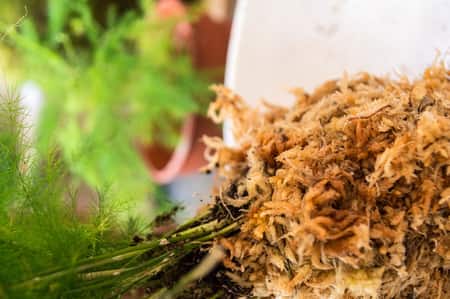
Different pests have peculiar habits, so keep an eye out for peculiar actions, like: color, aggressiveness, night/day lifestyle, damage to leaves, and amount of eggs laid.
What bugs live in sphagnum moss? Springtails, Spidermites, Aphids, Thrips, Fungus Gnats, and Mealybugs are all inscets and pests that inhabit the orchid’s potting medium, specifically sphagnum moss. At the end of each sphagnum moss bug, I’ll include several treatments and solutions to keeping these insects far away from your orchid.
1. Sphagnum Moss Bug: Springtails
Springtails are not harmful to your orchids. They aren’t known to transmit any kinds of diseases or hurt your orchid. Springtails eat the decomposing material in your potting medium, which actually makes them a good little critter to have around, especially in terrariums.
When creating a closed terrarium, always add springtails to keep the green mold off the sides of the glass and the decomposing material down to a bare minimum.
Springtails appear on your orchid because they like to live in humid climates. They are attracted to higher levels of humidity and thrive in sphagnum, which provides both.
In humid areas, they munch on decaying leaves, old rotten bark, leaf litter, and other dead material. The sphagnum also aids their appearance in your orchid because it’s so airy, and oxygen can circulate freely in the potting medium. You’ll notice these little guys like to jump, and their movements is very similar to fleas. Because of this, they have been named “snow fleas”. The snow part is that they survive in extremely low temperatures, and can be found in the snow. (The only little critters that survive winter…ugh!)
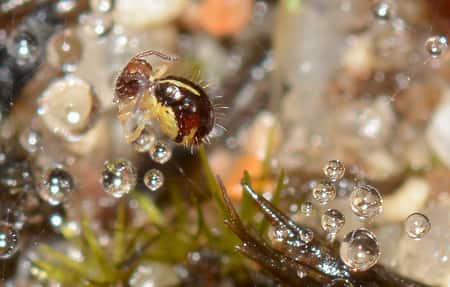
Usually you can hardly see them, except when they are white and jump around in the dark potting medium. Springtails are no bigger than 1-2mm or 1/16 of an inch long. The most commonly ones sold online for vivariums, palladariums, and terrariums are mostly white. In nature, you can find them in various colors and patterns.
If you see these little critters talking a stroll along your orchid, just bid them a “Good day” and let them be. They are way too beneficial to try to eliminate. Just think of them as an added bonus: people pay to add springtails to their terrariums, and you got them for free.
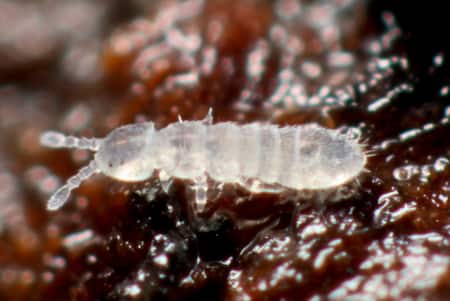
If they do happen to become an infestation and proliferate too much, you can use a sticky tape and they’ll jump into it eventually. This method is my preferred for springtails because there’s no use harming useful dudes, who happened to be in the wrong place at the wrong time.
2. Sphagnum Moss Bugs: Spider Mites
If your orchid has a string like web near the leaves and crown, you probably have spider mites. Spider mites are the most common orchid plague and can do some considerable harm to your plant, since they feed on “orchid juices”.
Spider mites are also very tine, only 0.4mm long, way tinnier than the springtails. You probably can’t see them, but will see their webbing, hence the name, Spider mite. What attracts the spider mites to the sphagnum moss is the temperature and the wind current. They grow rapidly in hotter climates, especially those with a little current to keep them happy.
If not treated, spider mites will make the leaves drop. As they suck on the nutrients inside the leaf, tiny dots, like freckles appear. This stippling effect on the orchid’s leaves is the first sign, besides the web, of course. When too many circles appear, the leaf could appear a bronze-like color.
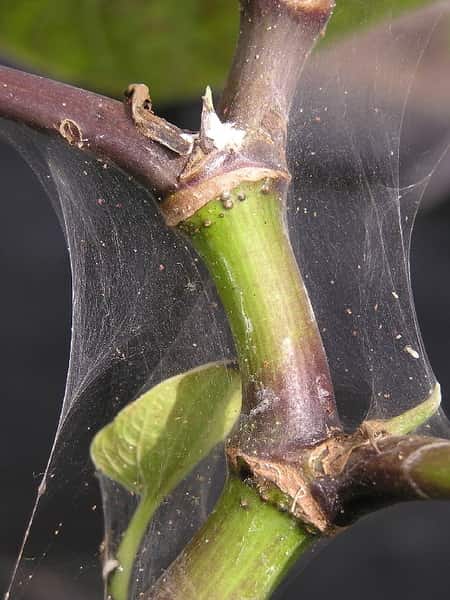
Spider mites only live one week. This is good news, because you can wipe out an entire generation in seven days, and reapply treatment for the second week just for eggs. Talking about eggs, one female spider mite can lay from 50 to 100 eggs in that week. So act fast, as soon as you see the webs or spotted freckles.
The best way to treat spider mites on your orchid is with neem oil every three days. I use this one (Affiliate Link ). You also can use other products, like pyrethrins, azadirachtin and horticultural oil. Spray your orchid thoroughly (and repot it too, since the potting medium is naturally airy and spider mites can run to the medium to keep safe.)
). You also can use other products, like pyrethrins, azadirachtin and horticultural oil. Spray your orchid thoroughly (and repot it too, since the potting medium is naturally airy and spider mites can run to the medium to keep safe.)
One thing to remember when applying neem oil: lighting will be intensified, so leaf damage can occur. It’s like going to the beach and rubbing tanning lotion all over your skin. It enhances the sun’s rays to get that lovely bronze color.
(Only in my dreams… I get lobster-red, but that’s another discussion. It’s always sunscreen SPF 80+ for me.) Move your orchids to a lower-light setting when your spray with neem oil.
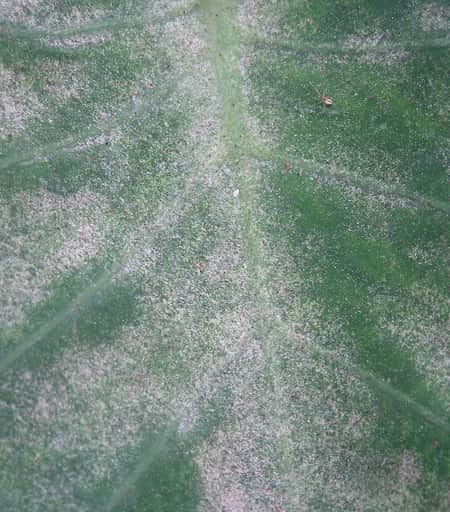
Heads up:
Neem oil will stink.
But don’t worry, it’s not toxic or corrosive…
But be prepared.
Another natural but less conventional way to kill spider mites is to introduce a natural predator to your orchids.
Hey, before you click out of this article saying, “no way am I buying an insect and releasing in inside,” hear me out. This one is actually cute: ladybugs. You can purchase ladybugs online “Bug Sales” is a brand that has a great value for the price (Affiliate Link ). Introduce them slowly in your orchid collection. They will eat the spider mites and mealy bugs, too. It’s a natural way to control the infestation, and add a little charm to your collection.
). Introduce them slowly in your orchid collection. They will eat the spider mites and mealy bugs, too. It’s a natural way to control the infestation, and add a little charm to your collection.
3. Sphagnum Moss Bugs: Aphids
Spider mites might be more common, but aphids are the worst insects for your orchids. Aphids not only suck out the sap form the stem, crown, and leaves, they also leave behind a sappy residue. This attracts other insects and opens a door for bacteria, fungus, and viruses—an open invitation for the microorganism world.
Aphids can come in many colors, shapes and sizes, since there are 5,000 species of aphids. That’s way too many! They are also very hard to control once they infest an plant, since most are already resistant to the pesticides that are sold commercially. Since aphids destroy crops and plantations, many chemical products have been released into the market, which was good initially, but over the years just made these little devils stronger. To recognize an aphid, they are among the slower moving bugs on your orchid.
They will calmly stroll along with not a worry in life, as compared to springtails who hop avidly everywhere.
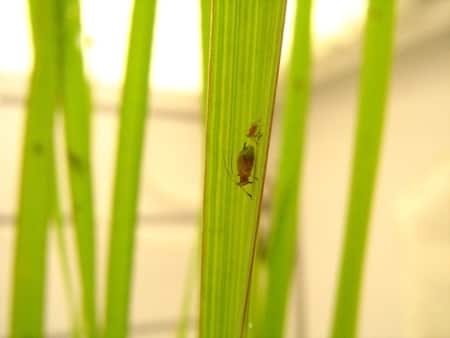
Aphids will tend to live under the leaves, and not on top. They find the protection in the leaves, and will feed on them. The first sign of aphids is a yellowing leaf, since the aphids are retaining most of the nutrients for themselves, depriving the leaf.
Aphids will also leave behind a trail of sap that is sticky when you touch it. This is a sign to other insects that your orchid is a reputable eating joint, and give it 5 stars. If not treated, this sap will soon attract ants, bees, and wasps. The sap also turns into black mold, since it attracts microorganisms. As you can tell, aphids are the first domino lined up for a sequential domino-trail into your orchid’s death.
To treat aphids, you need to shock them with a temperature change. A powerful cold jet of water would manually remove them from the leaves. Take your orchid to the sink and wash in in the coldest water you can manage.
There’s an old wise saying which says, “fish die through their mouths,” which mainly means, keep your mouth shut. Well, aphids do too. Several home remedies to killing aphids is sprinkling household items on your orchid and the aphids will eagerly digest them, only to die. One of these items is flour. Yep, flour. Sprinkle flour on the leaves of your orchid and all over the sphagnum moss. Flour will constipate the aphids and they’ll soon die. Another die-by-mouth technique is cayenne pepper.
Burn, baby burn.
I know, this advice sounds a bit nontechnical, but it really does work.
If you’re skeptical about using flour and a bit of hot-sauce, then you can wash the leaves with a mild-soap blend, but don’t rub the bottom part of the leaf. Just spray the soapy solution on and reply every two days.
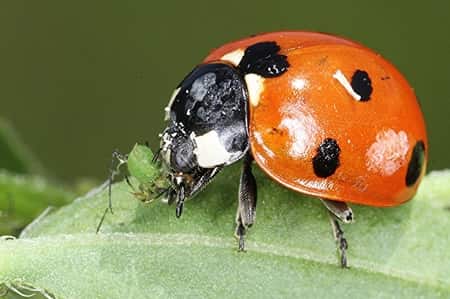
If you are aiming at a more proven method, try Diatomaceous Earth (Affiliate Link ). This powder is in fact microscopic glass blades, as sharp as razors. The aphids eat this (don’t ask me why) and the DM rips their intestines apart.
). This powder is in fact microscopic glass blades, as sharp as razors. The aphids eat this (don’t ask me why) and the DM rips their intestines apart.
Bloody, cruel, but well worth the investment. I don’t have to mention to use a mask and gloves when using this product, right?If you’ve had aphid in the past and want to prevent them from attacking the sphagnum moss and your orchid again, place a pot of catnip next to your orchid. The smell repels aphids, and they munch elsewhere…but do keep an eye out for your cat.
4. Sphanum Moss Bugs: Thrips
And our last little critter for this article is called thrips. Thrips are probably the easiest to diagnose because their bodies are long, slender, centipede-type insects and because they are easier to see, with 0.5 to 14 mm (0.02 to 0.55 in). The other bugs and pests mentioned here are all pear-shaped or rounder and smaller. You usually can spot the others because they live in clusters, and like a extended-family housing, all bunch up together.
One way to diagnose if they are in fact thrips, blow on your orchid. Thrips like to have a little air circulation, and will move toward the current. If you see movement when you blow, then you have thrips.Even though thrips have wings, they don’t fly very well. It’s more like they paraglide.
This is important to know because they can move in between plants easily, so if you have an orchid infected with thrips, then move it to another location.
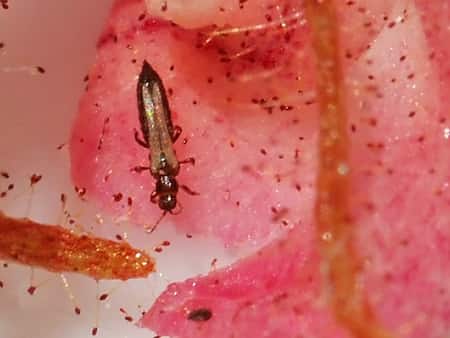
Thrips harm your orchid, but they do more harm because they carry more than 20 types of viruses on them. Then they damage the surface of your orchid’s leaf, they open the gateway to hard to treat infections.
Thrips are a pain to orchid growers, not because of the viruses, but because these little dudes reproduce asexually. Once you have one, you have thousands. And with them, thousands of names: thunder flies, thunder bugs, storm flies, thunder blights, storm bugs, corn fleas, corn flies, corn lice, freckle bugs, harvest bugs, and physopods.
Thrips have become the preferred lab specimen for testing new pesticides and chemicals, since they reproduce fast. Unfortunately, they have become immune to most commercially grown pesticides on the market, which makes them a pain to kill. The use of red-purplish lights has been successful in reducing the number of thrips, but let’s be logical, you’re not going to buy a grow light because of these guys.
One sign that your plant has thrips are little black spots. Unlike the spots that the spider mites produce, these black dots are Thrips excrements. How lovely.
A common question that has appeared is are there some thrips that are beneficial to your orchid? Yes. This is true. Some thrips will eat fungus, bacterial, mold and all the like, but frankly, I’m not going to sit round and wait to see who’s who. Just wipe them all out.
For treatment, you can use hydrogen peroxide in a spray solution, or a soapy solution and spray your orchid every three days. Hydrogen Peroxide is easy to find, but if you don’t have a bottle on hand, try this one (Affilaite Link ). Also, before using Hydrogen Peroxide, take a look at this article I wrote on why I don’t use it for normal orchid care.
). Also, before using Hydrogen Peroxide, take a look at this article I wrote on why I don’t use it for normal orchid care.
Thrips have a longer life span (around 20 days), and whatever treatment you decide on using, you’ll need to extend it for a month or two.
Another solution is to get a carnivorous plant, like Venus fly trap or a butterworts, which attracts these bugs out of your sphagnum moss and to their end. If that’s not your thing, you can try purple flowers: thrips love purple. (I know… this sound so unscientific and unprofessional, but yes, it does work. Kind of like the red light thing…)
Don’t Stop Learning!
If you want to be included in more information and get a 14-page fertilization guide, please sign up for my newsletter. I don’t spam, but send emails out bi-monthly with some curious topics of interest. If you want more information, click here to go to a specific page on this website where I explain it more in detail.

Also, if you are looking for an orchid journal to keep your notes specifically about orchid care, check out my 2 solutions for that on this page. If note-keeping isn’t your thing, then there is a free excel spreadsheet that you can download. Click here for more information on how to do that.
If you subscribe to my newsletter, I will send you a 14-page guide on the main tips of orchid fertilizer. It is downloadable and you can print it out on your computer. I designed the guide to double up as a coloring book, just to make it fun.
5. Sphagnum Moss Bugs: Mealybugs
There is one other little pest that could be walking around in your potting medium, which are mealy bugs. I had already written an extensive article on them before writing this article, so I won’t repeat myself here. If you want to look at that article on mealybugs, click here.
I hope you can identify the problem in your sphagnum moss and find a way to properly deal with it. Healthy orchids are the first priority. If you have more suggestions or have used ideas that have worked for you, leave them in the comments below.
Happy Cultivating!


The sticky sap I have is on the underside of the leaves. They look like little bubbles. I’ve looked for bugs and I see nothing!
I have pics if it would help.